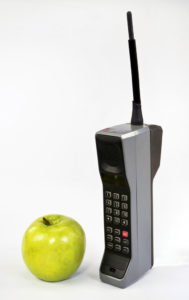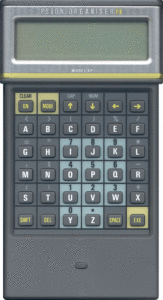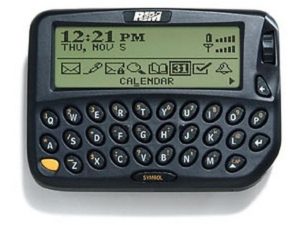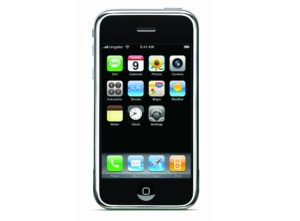Smartphones have become a hallmark of our time. The smartphone has enabled a stream of new applications and become a topic of many debates. Its presence is now being questioned during dinner, driving and in bed. Clearly it has an unavoidable nature and far reaching influence. This article is the third in a series of four on product evolution. They illustrate how technological evolution can explain ‘the origin of products’. Obviously, this type of evolution is different from what we are used to with biological species.
Landline telephones
The first patent for the electric telephone was granted in 1876 to Alexander Graham Bell. However, there is disagreement about who should be given credit for the invention of the telephone as several pioneering inventors worked on devices to transmit spoken word.

In the following decades the network systems of landlines were built and use of telephones spread. The first telephones used were simple wooden boxes to which a speaker and mouthpiece were connected. From the initial box designs, the so-called candlestick telephone evolved in the 1890s and became hugely popular. It still consisted of a separate mouthpiece and speaker but got rid of the box. In these days the telephone exchange required manually operated switchboards to make connections. This opened up new job opportunities for women as switchboard operators. The telephone soon proved to be an indispensable tool for trade and fuelled economic development. All in all the telephone and its network system had a large societal impact.
The telephone soon proved to be an indispensable tool for trade, fuelled economic development and had a large societal impact
Increased demand made landline networks evolve from hand-operated switchboards to mechanised pulse networks for which the telephone received a dial. Further increasing demands fuelled development towards tone networks which are operated by push buttons using the 12-digit keypad we still find on smartphones. Again driven by increasing demands, networks evolved to digital transmission.
Mobile phones
Just like for landlines, the history of mobile phones is intertwined with a series of consecutive network technologies. The first experimental mobile networks developed to circumvent restrictions of landline-based telephones are collectively designated by the name 0G. These 0G networks could only handle few calls and were very expensive.

The first commercially operated wireless telephone networks are referred to as 1G and used analogue network technologies. These networks are made up of many cells, each with its own base station, which connects to the terrestrial phone network. The base stations allow connections being handed over from one cell to the next. Hence the used devices are also named cell phones. Without this cell network structure mobile phone users would not be able to travel while calling.
The first 1G cellular network was launched in 1979 in Japan by the Nippon Telephone and Telegraph (NTT) company. The technology spread and in 1981 Denmark, Finland, Norway and Sweden received their Nordic Mobile Telephone system. Then in 1983 also in the USA a 1G network became operational using the Motorola DynaTAC 8000X mobile phone. Now referred to as the ‘brick phone’, this first of a kind weighted about 800 grams and was priced close to four thousand dollars or more than three times the average worker’s monthly salary. Nevertheless, because of its novelty soon after introduction there was already a waiting list. The following years Motorola developed into a leading mobile telephone manufacturer.
The second generation of wireless telephone networks also referred to as 2G are based on a standard developed in Europe. The protocol used by 2G is based on the Global System for Mobile Communications and simply referred to as GSM. Deployed in Finland in December 1991, 2G was the first digital cellular network.
Short Message Service (SMS) soon became hugely popular and a cash cow for mobile operators around the world
Building on the success of early mobile phones additional text messaging services were developed using the same network technology. This became known as Short Message Service (SMS) and was commercially introduced in 1993 in Finland. SMS did not require any additional infrastructure and soon became hugely popular. This made it a cash cow for mobile operators around the world in the years to follow.
The first mass-produced GSM telephone was the Nokia 1011 introduced in 1992. The popularity of the mobile phone opened a huge market and production numbers rose rapidly. Many other companies started producing mobile phones, however Nokia and Motorola dominated the market. The mobile phones later became known as feature phones (to distinguish them from smartphones). Feature phones have been produced in a few typical designs known as candy bar, clamshell and flip phone.
By 2002 the number of mobile phones had outgrown the number of landline phones in use
Feature phones became a huge success. Annual production amounts of feature phone handsets rose to well over hundred million a year by end of the 1990s. By 2002 the amount of mobile phones had outgrown the amount of landline phones in use. The wide availability of mobile phones changed our perception of what it means to ‘keep in touch’.
It transpired that mobile phones could be used for other purposes then making phone calls and texting. Mobile banking is an example of a novel type of use for a mobile phone. In the Philippines, SMS has been used to transfer money since 2005. As many people in developing nations do not have access to banking systems, this new service was well received. Besides the cost of using traditional banking services are often too high for the poor effective excluding them. A same service started in 2007 in Kenya and has spread since then across the African continent. It has become known as SMS banking and can be used for various forms of money transfer e.g. like purchases, salary payments or cash redraws without bank offices or ATMs being around. In this way, mobile phone technology has contributed to the economic development and provided many new jobs in developing countries in a similar fashion as landlines did in North America and Europe more than a century earlier.
Mobile phone technology has contributed to economic development and provided lots of new jobs in developing countries
Over the years, users of mobile phones explored new types of use and expectations of our mobile devices rose. The networks also became used as a means to transport digital data next to voice. Again the developments placed increasing demands on mobile networks. In response, a set of new network technologies and standards collectively named 3G were developed. NTT DoCoMo launched this third generation network technology in Japan in 2001. Other countries and network operators soon followed. The availability of this new network standard spurred the development of many new applications like streaming media that required ever more bandwidth. As a result of the growing bandwidth-hunger the telecom industry began looking for ways to optimize network technologies for larger amounts of data. These new standards became known as 4G and are together with 3G in use at time of writing of this article. As the amount of data we use still increases, it is likely that new network technology (which is currently under development) will be made available in the future to cover increased demands. This new standard will then be known as 5G-network technology.
As a result of the growing bandwidth-hunger the telecom industry began looking for ways to optimize network technologies for larger amounts of data
Personal Digital Assistant

In the beginning of the 1980s, advancing technology provided mankind with new devices like the home computer; later was renamed to personal computer, or PC. The decreasing size of electronic components and improving battery technology allowed first experiments with mobile computing devices. An example of this is the Personal Digital Assistant or PDA, a small mobile computing device that was designed to help organizing business life by providing agenda, address books, calculator and memo functionality.
The first PDA to be brought to the market was the Psion Organiser I introduced in 1984. It looked like a desktop calculator with a small display 6 by 6 keyboard and included a plastic sliding cover. The term PDA was first used for the Apple Newton, which was introduced in 1993. The Newton provided stylus to write on the touch screens. Special handwriting recognition software made it possible to transfer scribbles into digital text. Although the Newton was not a huge commercial success, it heralded the transition from mobile devices with full keyboard towards a touch screen and virtual keyboard. A range of competitors brought PDAs to the market of which the PalmPilot is one of the most notable.
To synchronize agenda and email with the more elaborate versions of the same applications used on the PC early PDAs connected to the first by cable using the serial port which after some years was ousted by the USB (that was introduced in 1996). Later versions often use Bluetooth and or WiFi as means to synchronize data. Wireless connectivity made it possible that mobile email and Internet access functionality were added to the PDA.
Early hybrids


The Simon Personal Communicator introduced in 1994 by IBM, was the first mobile phone with touch screen and PDA functionality. It featured 11 built-in typical PDA applications including a calendar, appointment scheduler, to-do list, address book, calculator, world time clock, electronic note pad/sketch pad, handwritten annotations and stylus input screen keyboards. Being the first to combine mobile phone and PDA functionality, the Simon is now also dubbed the first smartphone although that name was not yet used at that time.
The Simon Personal Communicator, which was introduced in 1994 by IBM, is dubbed the first smartphone being the first mobile phone with a touch screen and PDA functionality
PDAs appeared to be fertile platforms to experiment with hybrid variants. In 1999 Research In Motion (RIM) introduced a PDA annex two-way pager named BlackBerry 850. The device supported email, limited HTML browsing and featured a monochrome screen. From 2002 BlackBerry models featured mobile phone functionality. The BlackBerry still used a physical QWERTY keyboard and became a hit amongst business executives because of its secure email server.
Smartphones

A decade after the Simon Personal Communicator was launched, many mobile electronic devices became available. One of these types was portable audio player for which the Walkman, introduced by Sony in 1979, marked the birth. The first of these devices used analogue tape cassettes, which later evolve towards digital versions using CDs or magnetic discs. Apple cunningly combined available electronic components in the iPod, a first successful mobile audio player using a small hard drive. The iPod became known for its handy user interface and iTunes store that was used to distribute audio and video. Then Apple integrated the iPod, Newton and mobile phone technology in a single device, the iPhone that it introduced in 2007. The first model could only use 2G-network technology and is therefore sometimes referred to as the iPhone 2G. The App Store was not yet available. We now know it was not the first device to combine functionality we now associated with the smartphone. Nevertheless it is now looked upon as the decisive step in the evolution of the smartphone as it was the first to completely do away the fixed keyboard and use a touch screen allowing multiple gesture control on a touch screen and included a camera. Besides, it combined not only basic application like phone, agenda and email but also a range of new applications. The new design with touch screen and the built in many sensors became a sensation and changed industries involved.
Apple integrated the iPod, Newton and mobile phone technology into a single device, which became the iPhone, that was introduced in 2007
Since 3G-network technology became available the increased bandwidth allowed many data hungry mobile applications. Together with increasing computing power and ever more and better sensors this fuelled the amounts of applications available for smartphones, which now appear almost endless. When Apple’s App Store stared in 2008 it offered 500 apps. Early 2017 the amount apps featured increased to a stunning 2.2 million. Google opened a same store for its Android OS in 2009 and now features a similar amount of apps.
According to research done in 2012 by O2, a mobile telecom operator, the telephone functionality only ranks 5th after Internet browsing, social network use, playing games and listening to music. More recent research by Pew Research Centre (2015) shows a slightly different ranking of typical use of smartphones, but the trend is the same. Types of use we would associate a decade ago with PCs or PDAs are now most common on smartphones. Although we still refer to the device as a (smart)phone, making calls is not among the most frequent types of use anymore. In the meantime PDAs have become obsolete and the feature phone is being ousted by the smartphone. Smartphones have become indispensable tools for many types of communication, access to information, navigation and the functions provides by early PDAs. They have made us busier. However, it is debatable as to whether smartphones have made us more productive.
Although we still refer to the device as a (smart)phone, making calls is no longer one of the most frequent types of use
Mobile computing platform
Being a mobile computing platform, the smartphone heavily relies on its mobile operating system (OS). The OS is an essential part of a computing platform that manages computer hardware and software resources and is thus crucial for a smartphone allowing it to run third-part software. At time of writing Android was installed on nearly 82% of all sold smartphones and iOS on nearly 18%, leaving less than 1% for all other mobile operating systems. Android being provided by Google is an open source system being customised before installation by smartphone vendors like Samsung, Huawei and many others.
Also for other mobile devices dedicated operating systems have been developed with Palm OS used on PDAs as a successful example. More recently also ‘smart watches’ have been marketed using a similar OS as smartphones.
Digital socializing

Smartphones together with the related tablets, have has become our favourite mobile device for accessing Internet. Social networks like Facebook, Twitter and LinkedIn become heavily depending on their mobile access. Presence of high quality digital cameras on smartphones makes them the device of choice to use for interacting on social networks. In recent years Internet has contributed to changing social norms. Online dating has become commonplace and Tinder, a popular app launched in 2012 used to swipe through profiles on smartphone screens, had already over a million paid users in 2016 and at least an order of magnitude more unpaid accounts. With Tinder swiping left become the new normal for rejecting potential dates.
Smartphones have become addictive devices
Although it is known that the blue light produced by smartphone or computer screens makes it more difficult to fall asleep it is not uncommon for smartphones to be used in bed. During dinner and other social activities the use of smartphones is considered undesirable and stirs many discussions. And in traffic it is a known cause of accidents, unfortunately also with deadly consequences. Being social animals with a congenital urge to keep in touch with others, we must face that the smartphones have become addictive devices.
Smartphones have become the platform of choice for many types of applications. What initially was regarded as a mobile phone with additional functionality has become more of a personal communication and computing hub. Just as it was hard to imagine two decades ago how we now use this device, it will be hard to imagine what will become of it in another two decades. Further increasing computing power and new technologies like artificial intelligence (AI), augmented- and virtual reality will probably fuel new application areas. As logic consequence types of use will continue to change in the future. It is obvious the evolution of smartphone has by far not yet come to a standstill. Socializing is set to continue change.

The evolution of smartphone has in no way come to a standstill yet and socializing will continue to change
Conclusion
The smartphone could not have been invented if the mobile phone and the personal digital assistant had not been around before. These earlier products and other enabling technologies were conditional for the smartphone to emerge.
Once the smartphone took off, it further evolved towards a personal communication and computing hub. The phone functionality moved to the background and new forms of socializing took command. Our desire to socialize is innate and surely not an effect of new technologies, rather a cause for their further development. It is therefore clear that the origin of the smartphone is not a self-contained and sudden invention. Earlier products and influences from the environment play a crucial role in the evolution of products as is shown here in the case of the smartphone.
Copyright © 2018 Huub Ehlhardt. All Rights Reserved. Please contact us for re-use of this article.
The book ‘On the Origin of Products’ is available via Cambridge University Press, Bol.com and Amazon. This site also provides an introduction to this title.


Thanks, it’s very informative
I spent a great deal of time to find something such as this
This article erases years of smartphone history not talking about Nokia Symbian smartphones, Microsoft Mobile devices, Palm, etc.
The article attempts to place the development of the smartphone in an evolutionary perspective. Therefore, it goes far back in the history of the development of the phone and places it in a broader context. It does not intend to name ALL variants and precursors of the smartphone.
Interessant artikel. Compliment,
Dank!